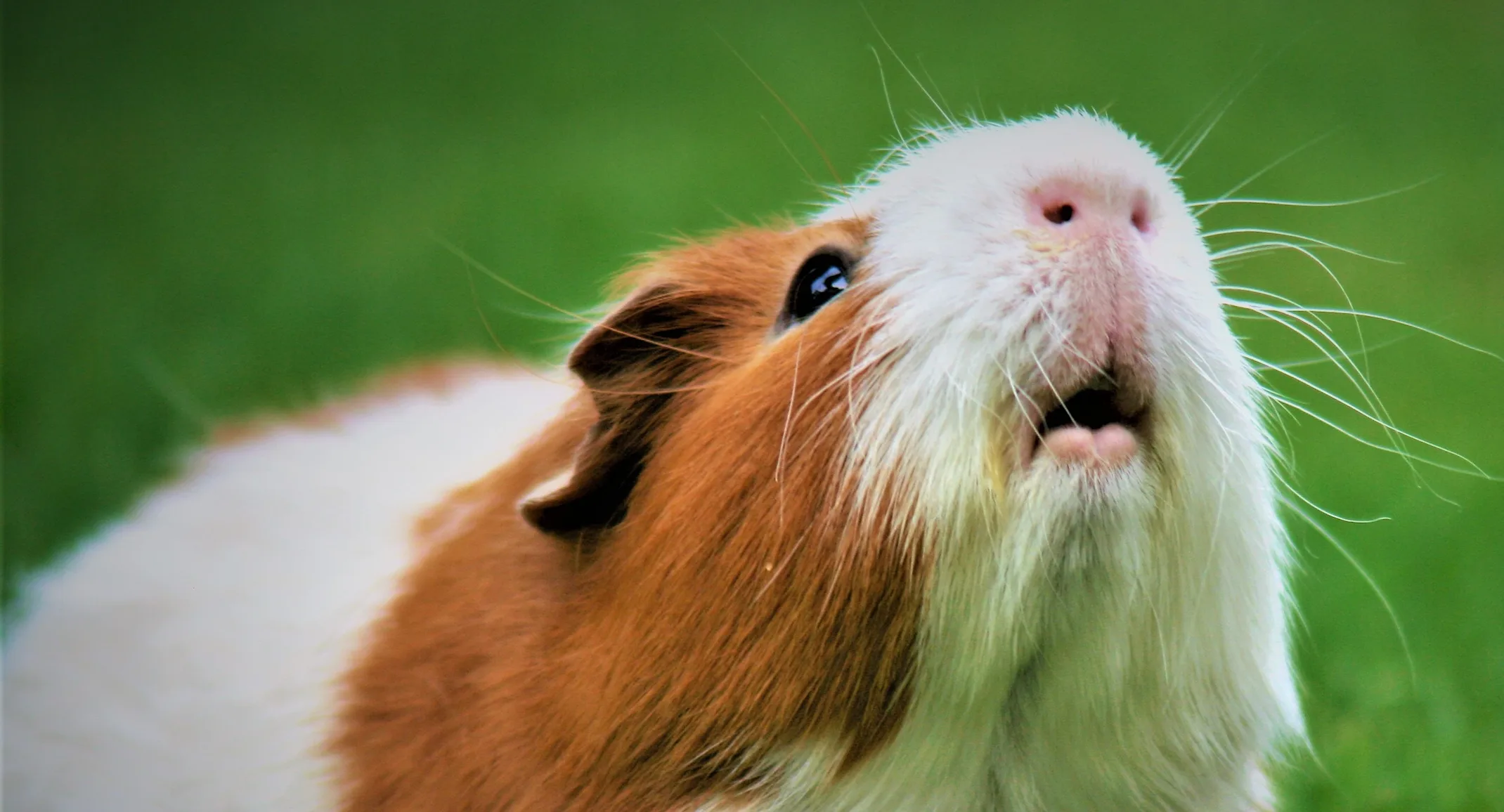Basic Husbandry
General Information –
Vital Statistics
Body Weight: 1.5-3 pounds (depending on breed)
Life Span: 4-8 years (depending on breed)
Sexual Maturity
Males : 2-3 months of age
Females : 2-4 months of age
Behavior and Handling
Guinea pigs should always be held gently with two hands. When picking up a guinea pig, always support its hind end because the guinea pig’s powerful rear legs can cause serious spinal injuries if it kicks while being held.
When handling your guinea pig, try to avoid excessive noise, needless excitement, and over handling.
Children handling guinea pigs should sit on the floor and hold the guinea pig in their lap. Children should only hand guinea pigs under adult supervision.
Guinea pigs do not adapt well to changes in their food or environment. Hair barbering (chewing of the fur) may occur in situations of stress and overcrowding. If this occurs, please contact your veterinarian.
Reproductive Information
Guinea pigs can be spayed or neutered as early as 6 months of age.
This is recommended if cohabiting males and females, to reduce aggressive behavior, or to treat medical conditions.
Housing
Guinea pigs should be housed in a cage that is a minimum of 3 ft. x 4 ft.
The cage bottom should be solid plexiglass, hard plastic, or stainless steel. If the cage bottom has a wire mesh bottom, half should be covered with a solid surface to prevent sores from developing on the bottom of the feet.
The substrate or cage bedding should consist of a paper pulp product (like CareFresh), newspaper, or computer paper. Wood base products such as pine or cedar shavings are not recommended because they may lead to the development of allergies and upper respiratory infections.
Alternatively, many owners use fleece cage liners or towels for the base of the cages for ease of cleaning and for a softer surface.
Your guinea pig’s cage should be spot-cleaned daily where any soiled bedding, hay, or excrement should be removed. It should also be deep cleaned weekly with warm water and mild soap. You may also use a dilute (1:30) bleach/water solution.
Guinea pigs should be allowed out the cage for supervised play time and daily exercise. This will encourage your guinea pig’s interactions with family members. We recommend at least 1 hour of exercise per day.
Do not allow your guinea pig to chew on household items when it is out of its cage. Safe chew items should be offered, such as cardboard, baskets, wood, small mammal specific toys, etc.
Litterbox Training
A litterbox can be offered at all times and only paper-pulp products should be used as litter (CareFresh or Yesterday’s News).
Clay or clumping cat litter should not be used because they can cause eye, skin, and respiratory problems.
Encourage your guinea pig to use its litterbox by putting a few fecal pellets in it and the placing the box in the guinea pig’s favorite place to eliminate.
Diet
Timothy hay should be offered as “free choice”. (as much as they can eat). Hay should consist of 75%-80% of the diet.
Timothy based pellets such as Oxbow’s Adult Guinea Pig Pellets should be offered. We recommend feeding around 1/8 cup daily.
Pellets should always be uniform and not a mix of seeds, nuts, and fruits. When given the option, a guinea pig will choose the things they like of those mixes which can predispose them to obesity and dental disease.
Give low calcium greens such as
Red and/or Green left lettuce.
Escarole
Watercress
Clover
Swiss Chard
Bok Choy
Endive
Turnip Tops
Romaine Lettuce
AVOID dark lefty greens such as; kale, parsley, dandelion, collard greens, turnip greens, mustard greens, and broccoli due to their high calcium content.
Small pieces of apple, bananas, berries, melon, or carrots may be offered. It should only be given in small quantities and only as treats. They can be given a couple times a week. Avoid giving them daily.
Fresh water should be offered at all times in either a sipper bottle or spill proof bowl. Most guinea pigs drink from bottles.
Clean food and water dishes every couple of days in the dishwater or soak them in a dilute (1:30) bleach to water solution.
Common Medical Conditions
Conditions Requiring Veterinary Attention
Gastrointestinal Stasis (GI Stasis)
This is a common syndrome in guinea pigs. Most commonly, these guinea pigs have decrease in appetite or stop eating completely. The stools will become smaller and drier. The guinea pig may even stop producing stools altogether.
Immediate medical attention is necessary to maximize chances for a successful recovery. Without proper treatment, GI Stasis can be fatal. Guinea pigs often have an underlying cause of GI stasis which must be identified for complete resolution of clinical signs.
Common examples include respiratory infection, urinary tract infection, bladder stones/sludge, dental disease or gastrointestinal parasites
Malocclusion of Premolar and Molar Teeth
This is a very common problem in guinea pigs. These guinea pigs may become picky about what they eat, stop eating and may drool or slobber. They may also have drool on their front legs from wiping their mouths. Weight loss is also common.
Treatment includes sedation to trim the molars. This can be a reoccurring problem. Severe malocclusion can result in the entrapment of the tongue and complete inability to eat. This is an emergency condition.
Respiratory Infections
Symptoms include; sneezing, difficulty breathing, runny nose, runny eyes, and decreased appetite. Treatment usual includes oral antibiotics.
If untreated or clinical signs are subtle, respiratory disease can rapidly worsen resulting in a pneumonia. Guinea pigs are obligate nasal breathers (breathe only through their nose). If you ever notice you guinea pig breathing through their mouth, this is a sign of severe respiratory distress.
Bladder Stones/Sludgy Bladder
Guinea pigs may show signs of a bladder stone or sludge in the bladder. A stone is a discrete mineralized deposit whereas sludge is a clay-like sediment that can build up in the urinary bladder. High calcium diet may predispose guinea pigs to these conditions.
Common signs include straining to urinate, frequent urination, grunting, abdominal discomfort, or blood in urine. Radiographs (x-rays) and urine analysis are necessary to diagnose these conditions.
Vestibular Disease
Vestibular disease refers to a disease process of the middle ear, inner ear, or brain. Some of the common signs include head-tilt, rolling, nystagmus or “type writer eyes”, or loss of balance.
Common causes of Vestibular disease are bacterial infections, ear infections, protozoal infections, and trauma. If you notice any of these signs in your guinea pig, contact your veterinarian immediately.
Vestibular disease can be treatable if caught early but can be a reoccurring problem. Treatments may include aggressive, long-term antibiotic therapy and possible deep-ear cleanings.
Common Skin Diseases
Cheyletiella (Walking Dandruff) and Sarcoptes (mange) are mites that cause generalized scaling and crusting of the skin. Treatment may include injections and/or powders that safely eliminate the parasites.
Ringworm is a highly contagious fungal infection of the skin that is transmissible to humans. Symptoms include raised, hairless, red patches that are often covered with a light-to-heavy crust. Treatment consists of the applications of topical antifungal medication and often oral antifungal medications.
Pododermatitis (“Bumblefoot”) is a pressure sore/swelling that can develop on the bottom of the feet in some guinea pigs. This typically is seen in sedentary animals or older animals living in bedding that is damp or not cleaned thoroughly. Treatment consists of antiseptic soaks, pain medication, antibiotics, occasionally bandaging, and cleaning the environment thoroughly.
Cecotrophs
Cecotrophs or “night feces” are soft, mucous-covered feces that guinea pigs consume directly from the anus. Cecotrophs provide essential proteins, vitamins, and minerals. They also replenish a guinea pig’s normal bacterial flora.
Overweight guinea pigs often cannot reach their rectum and may develop diarrhea or matting of the cecotrophs to their hindquarters. Cecotrophs are commonly mistaken for diarrhea.
Emergency / Critical Care
All emergencies require veterinary assistance. Use the following guidelines to assist you in caring for your guinea pig until you can contact a veterinarian.
Traumatic Injuries
Broken Bones
Provide your guinea pig with soft bedding such as a towel or blanket.
Minimize handling.
Keep your guinea pig in a warm, dark, and quiet area.
Keep your guinea pig as calm as possible and contact a veterinarian or local animal emergency clinic immediately.
Skin Injuries/Blood loss
For any type of injury with blood loss, use direct pressure with a towel or clean gauze to prevent further blood loss. Contact your veterinarian immediately if you are unable to stop the bleeding.
Severe Illnesses and Other Conditions
Head Injuries and Head-Tilt
Provide your guinea pig with soft bedding like a towel, blanket or sheepskin.
Minimize handling.
Keep your guinea pig in a cool, dark, and quiet environment.
Keep your guinea pig as calm as possible and contact a veterinarian or a local animal emergency clinic immediately.
Respiratory Distress
If your guinea pig experiences open-mouth breathing or gasping for air, remove all bedding and minimize handling and stress.
Keep your guinea pig as calm as possible and contact a veterinarian or a local animal emergency clinic immediately.
Heat Stress
Temperatures over 85°F and/or high humidity are uncomfortable to guinea pigs and will cause your guinea pig to over-heat. It is better for your guinea pig that it be kept indoors all year round.
Common signs of heat stress include extreme lethargy, dehydration, diarrhea, and difficulty breathing.
Remove your guinea pig from heat immediately.
Offer cool water or cool Pedialyte to rehydrate.
Keep your guinea pig in a cool, dark, environment.
Limit handling.
Heat stress is a serious and potentially fatal condition for guinea pigs. Seek veterinary attention immediately.
Health Recommendations
Things for your veterinarian to do:
Annual Physical
Always have an initial physical exam performed on any newly acquired guinea pigs. During the exam, the doctor will check the teeth, eyes, ears, heart, lungs, and abdomen. The doctor will also check the hair and skin for external parasites.
You should also have your guinea pig’s fecal sample checked for internal parasites.
Your guinea pig should have an annual physical done by a veterinarian every year. We also recommend a geriatric exam every 6 months for guinea pigs over the age of four.
Bloodwork
Your guinea pig should have its bloodwork checked yearly starting around 3-4 years of age. This will help to detect early signs of disease. When caught early enough, many diseases are treatable.
Urinalysis
Normal guinea pig urine contains a lot of sediment (mainly calcium), varying in color from white to light brown.
A guinea pig under certain physiological conditions, such as stress, may produce urine that is orange or red-tinged and is often mistaken for blood.
If blood is suspected, your veterinarian can perform a urinalysis to determine whether it is blood or stress.
Things for you to do:
Hairball prevention (Long-haired breeds are more commonly affected)
Give 1-3 cc’s of laxatone, petromalt, or other cat hairball preventative 2-3 times a week.
Brush, comb, or use a lint roller on your guinea pig to remove any loose hair.
A high fiber diet that includes timothy hay is that most important part of a hairball prevention.
Overgrown Nails
Guinea pigs should have their nails trimmed on a regular basis. If the nails get too long, they can become caught on the cage or toys and break off causing pain and bleeding.
If any of the nails break off and begin to bleed, apply styptic powder, household flour, or cornstarch to encourage clotting, and apply direct pressure to the nail. If you cannot stop the bleeding, contact a veterinarian.
Nail trims are also recommended to prevent the nails from overgrowing and cutting into the feet.
Over-the-Counter Medication
Over-the-counter topical triple antibiotic ointments or any other types of over-the-counter medications are not recommended without first consulting your veterinarian. Productions such as triple antibiotic ointment (for the use of minor skin injuries) can cause digestive problems if ingested and can potentially become toxic over time.

